
Natick is bisected by Route 9. There is only one bicycle-friendly crossing, at Oak Street. Also, large shopping centers in the northwest section of Natick are at the same time a major trip destination and a challenge due to the difficulty of access on Speen Street.
This is the worst of Natick for bicycling. The best is that many minor arterials and collectors in the west and south of Natick -- Glen Street, Pleasant Street, Union Street -- are so lightly traveled that no improvement is needed unless development greatly increases traffic. Others would benefit from minor widening during repaving and reconstruction to serve residents and for through access.
Route 30: This highway, which passes through the north end of Natick, is marginally wide enough for side by side bicycle/motor vehicle lane sharing. Route 30 is important for bicyclists traveling between Framingham, Wayland, Weston and Newton. It provides access to the Lake Cochituate park area in Natick.
Route 9: is not a limited access highway and so is open to bicycle traffic. Bicyclists must use Route 9 to reach a number of destinations in Natick. There are shoulders except where occupied by right turn lanes. However, high-speed traffic and frequent on and off ramps and turn lanes make Route 9 unattractive for bicycling. Fortunately, there are serviceable parallel corridors.
Hartford Street and connection to Framingham between Routes 9 and 135: Hartford Street is too narrow for comfort during rush hour. There are streets south of it which form a through connection, however.
Bacon Street: beginning only a few feet from a lightly used railroad overpass over Route 9 (see below), Bacon Street is lightly traveled over its entire length and offers an alternate east-west route with connections to Route 135 and to a potential bicycle path in Wellesley (see Wellesley report).
Route 135: Though Route 135 is the main east-west route through the center of Natick, it is surprisingly bicycle friendly except for a few congested blocks at the middle of town. Even here, an alternate route a couple of blocks to the north is available. Route 135 has wide lanes and is an example of a highway well-designed, whether by intention or not, to accommodate bicycle and motor traffic together. Note that the two wide lanes of Route 135 change to four narrow lanes at the Wellesley town line (see notes in the Wellesley section of this report).
Route 16: This highway, which passes through the south end of Natick, is marginally wide enough for side by side bicycle/motor vehicle lane sharing. Route 16 is important for bicyclists traveling between Wellesley, South Natick and Sherborn.
Add width to Route 30 during reconstruction/repaving to maintain 14 foot lane/shoulder width. Design intersection upgrades on Route 9 to allow sufficient lane width for through bicycle traffic to the left of right turn lanes. Designate and sign a Framingham-Natick bicycle route on streets south of Hartford Street. Designate Bacon Street as a through bicycle route, and maintain its desirability as such. Examine the possibilities for connections at its two ends.
Retain the Route 135 cross section with two wide lanes, perhaps adding shoulder striping. In the center of Natick, examine the designation of an alternate route (for example Middlesex Ave - South Ave. - Dover St.) Add width to Route 16 during reconstruction/repaving to maintain 14 foot lane/shoulder width.
Provide an east-west corridor through the north end of Natick on Winter Street and Pine Street through minor widening during repaving and reconstruction to serve residents and for through access.
Speen Street: The lanes are wide, and Speen Street is bicycle friendly south of Route 9. However, north of Route 9, it serves a major shopping mall. The cross section was designed for prettiness rather than safety, with a wide median strip and narrow travel lanes. The multilane merges at the intersection with Route 9 and the heavy traffic make Speen Street unattractive here.
Speen Street north of route 9, with narrow lanes and median: not bicycle-friendly

Route 27: The major north-south route through the center of Natick, this has wide lanes. The grade separated crossing of Route 9 is bicycle-unfriendly, with added right turn lanes on the narrow bridge. Route 27 also encounters congestion in the center of Natick.
Route 27, Approach from north to Route 9 bridge in Natick
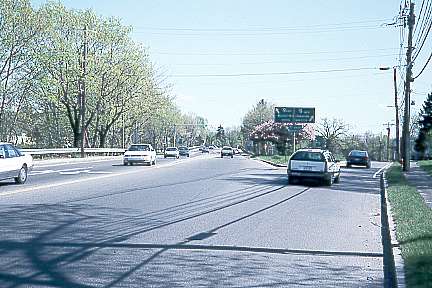
Oak Street: Providing a north-south route at the east end of Natick, Oak Street has an underpass at the Massachusetts Turnpike and a signalized intersection at Route 9. However, pavement width is variable and resident parking sometimes encroaches on useable pavement width.
When Speen Street is due for repaving, widen the lanes. Maintain the bicycle-friendly two-lane cross-section south of Route 9.
Retain the wide lanes on Route 27 and discourage on-street parking. However, consider the development of alternate crossings of Route 9 (see suggestions below). Retain bicycle-friendly features on Route 27 wherever feasible, for local access.
Add width to Oak Street during reconstruction/repaving to maintain 14 foot lane/shoulder width.
A bicycle-pedestrian overpass of Route 9 between Linden Street and Wethersfield Road, east of Route 27, would bypass the route 27 overpass and open up local streets in the northeast quadrant of Natick as through bicycle routes.
Railroad overpass (left) provides a potential crossing of Route 9
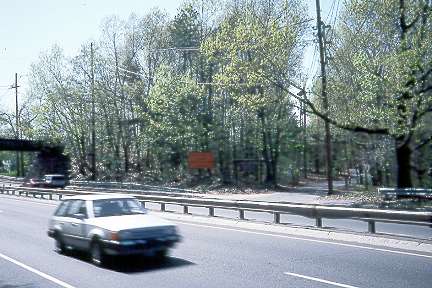
Branch of rail line turns left to cross Speen Street into shopping malls
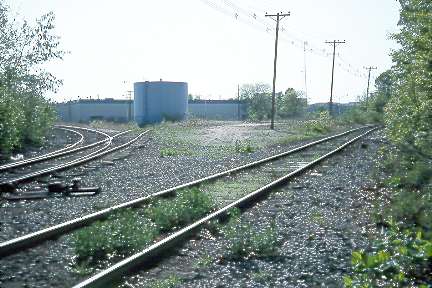
Grade crossing at Speen Street (no longer exists in 2004)
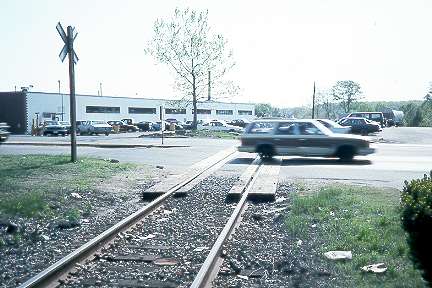
Location of railroad crossing on Speen Street.
Wonder Bread backery visible in right background.
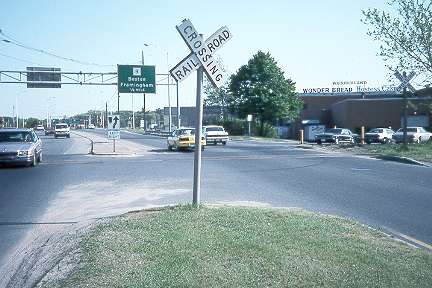
End of the line west of Speen Street: Wonder Bread bakery, now
(2004)
vacant

Natick-Saxonville Rail Spur: Extends from the center of Natick to the northwest, and includes an overpass over Route 9. Provides a route to the shopping centers and the Lake Cochituate recreational area; perhaps onwards as far as the Saxonville area of Framingham. This is still an active rail line almost as far as Route 30, though use is very light.
End of tracks south of Route 30, looking south

Railroad corridor, looking across Route 20 from north to south.
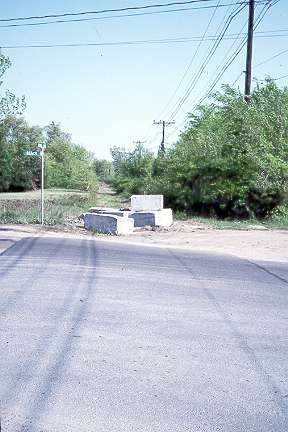
Railroad corridor, looking across Route 30 from south to north

Concrete blocks at left side of photo encroach on railroad
right-of-way
just north of Route 30
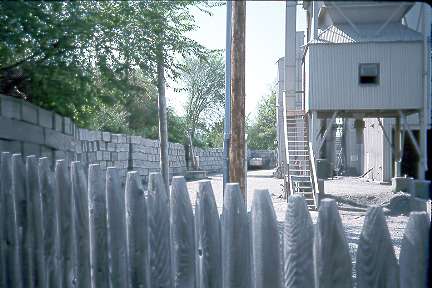
Cochituate Aqueduct/town park: in the northeast corner of Natick, this could include some connecting links.
Sudbury Aqueduct: passes through the south end of Natick.
Recommendations
Examine the feasibility of a rail trail and rail-with-trail conversion on the rail spur. This approximately 3-mile route would provide a vital link across Route 9. If use of the rail line is not possible, a path might be constructed in the adjacent state park, with a bicycle path cantilevered to the side of the railroad overpass over Route 9. Connections to the shopping centers should be provided. In the center of town, the route could leave the rail line and follow local streets and/or shore of the Cochituate Reservoir.
A path in the town park could provide a connection from the Cochituate aqueduct into the center of Natick. The Sudbury Aqueduct corridor, however, has more problems in Natick than in Wellesley, as the aqueduct passes through deep tunnels under hills. There are also issues of property ownership and easements. Its possibilities as a recreational trail, however, deserve investigation.